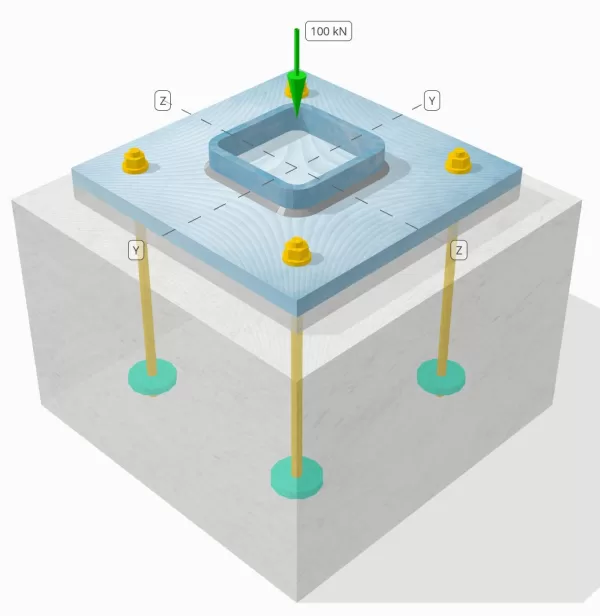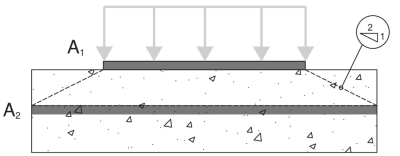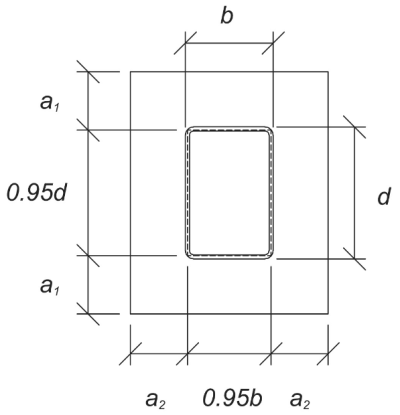基本板设计示例使用 4100:2020 并作为 3600:2018

问题陈述
确定设计的列板连接是否足以容纳100 kn压缩负荷.
给定数据
柱:
列部分: 50×10 SHS
列区域: 5260 毫米2
列材料: AS / NZS 1163 gr. C350
底盘:
基板尺寸: 350 毫米× 350 毫米
基板厚度: 20 毫米
底板材料: AS / NZS 3678 gr. C250
灌浆:
灌浆厚度: 20 毫米
具体:
混凝土尺寸: 450 毫米× 450 毫米
混凝土厚度: 300 毫米
混凝土材料: N28
焊缝:
焊缝尺寸: 6 毫米
填充金属分类: E43xx
仅通过焊缝传输的压缩负荷? 是的
SkyCiv 免费工具中的模型
立即使用我们的免费在线工具对上面的底板设计进行建模! 无需注册.
分步计算
检查一下 #1: 计算混凝土轴承能力
开始, 我们确定 轴承区域 每 作为 3600:2018 条款 12.6:

A1 - 底板轴承区域
A2 - 混凝土支撑轴承区, 预测在 2:1 坡
\(
a_1 = l_{BP} b_{BP} = 350 \, \文本{毫米} \次 350 \, \文本{毫米} = 122500 \, \文本{毫米}^ 2
\)
\(
a_2 = n_{A2} b_{A2} = 450 \, \文本{毫米} \次 450 \, \文本{毫米} = 202500 \, \文本{毫米}^ 2
\)
从那里, 我们计算 混凝土轴承能力, 表示为等效力. 我们使用 ASI设计指南 07 1圣 埃德. 部分 9.1 设计桁架时需要注意一些重要事项.
\(
\phi n_c = min 左( \φ 0.9 \剩下( f’_c 对) A_1 sqrt{\压裂{A2}{A_1}}, \φ 1.8 \剩下( f’_c 对) A_1 对)
\)
\(
\phi n_c = min 左( 0.6 \次 0.9 \时代左( 28 \, \文本{兆帕} \对) \次 122500 \, \文本{毫米}^2 times sqrt{\压裂{202500 \, \文本{毫米}^ 2}{122500 \, \文本{毫米}^ 2}}, 0.6 \次 1.8 \时代左( 28 \, \文本{兆帕} \对) \次 122500 \, \文本{毫米}^2 对)
\)
\(
\non -n_c = 2381.4 \, \文本{千牛}
\)
以来 100 千牛 <2381.4 千牛, 的 混凝土轴承的容量就足够了.
检查一下 #2: 计算焊接容量
评估焊接能力, 我们首先确定 总焊接长度 基于列尺寸:
\(
L_{\文本{焊接}} = 2 \剩下( b_{\文本{上校}} – 2 r_{\文本{上校}} – 2 t_{\文本{上校}} \对) + 2 \剩下( d_{\文本{上校}} – 2 r_{\文本{上校}} – 2 t_{\文本{上校}} \对)
\)
\(
L_{\文本{焊接}} = 2 \时代左( 150 \, \文本{毫米} – 2 \次 15 \, \文本{毫米} – 2 \次 10 \, \文本{毫米} \对) + 2 \时代左( 150 \, \文本{毫米} – 2 \次 15 \, \文本{毫米} – 2 \次 10 \, \文本{毫米} \对) = 400 \, \文本{毫米}
\)
有了这个, 我们可以计算 每单位焊接的压力, 假设 100 kn负载均匀分布:
\(
v^*_ w = frac{n_x}{L_{\文本{焊接}}} = frac{100 \, \文本{千牛}}{400 \, \文本{毫米}} = 0.25 \, \文本{千牛/毫米}
\)
在那之后, 我们确定 单位长度的焊接容量 使用 作为 4100:2020 条款 9.6.3.10:
\(
\phi v_w = phi 0.6 F_{你的} e_w k_r = 0.8 \次 0.6 \次 430 \, \文本{兆帕} \次 4.243 \, \文本{毫米} \次 1 = 0.87576 \, \文本{千牛/毫米}
\)
以来 0.87576 千牛/毫米 < 0.25 千牛/毫米, 的 焊接容量就足够了.
检查一下 #3: 计算由于压缩负荷而导致的底板弯曲屈服能力
底板的弯曲能力取决于其尺寸. 如果盘子太宽, 它需要更厚的材料. 为给定的负载选择正确的基板尺寸需要经验, 进行多次计算可能是耗时的. 的 SkyCiv底板设计软件 简化了此过程, 仅在几秒钟内实现快速有效的建模和分析.
我们使用 ASI设计指南 07, 1圣德德。, 桌子 7 检查基板弯曲屈服能力. 第一, 我们确定 Kx 因素.
\(
k_x = 1.65 \剩下( \压裂{\sqrt{L_{BP} b_{BP}}}{b_{\文本{上校}}} \对) = 1.65 \时代左( \压裂{\sqrt{350 \, \文本{毫米} \次 350 \, \文本{毫米}}}{150 \, \文本{毫米}} \对) = 3.85
\)
下一个, 我们根据面积的压力来计算混凝土轴承强度. 参考 检查一下 #1 计算出的轴承能力.
\(
\phi f_b = frac{\non -n_c}{L_{BP} b_{BP}} = frac{2381.4 \, \文本{千牛}}{350 \, \文本{毫米} \次 350 \, \文本{毫米}} = 19.44 \, \文本{兆帕}
\)
然后,我们使用此值来获得 X 因素.
\(
x = frac{4 N_C^*}{\phi f_b (2 b_{\文本{上校}})^ 2} = frac{4 \次 100 \, \文本{千牛}}{19.44 \, \文本{兆帕} \次 (2 \次 150 \, \文本{毫米})^ 2} = 0.22862
\)
现在, 让我们使用计算的 Kx 和 X 评估的因素 λ (拉姆达) 因素.
\(
\lambda = min 左( \压裂{k_x sqrt{X}}{1 + \sqrt{1 – X}}, 1.0 \对) = min left( \压裂{3.85 \次 sqrt{0.22862}}{1 + \sqrt{1 – 0.22862}}, 1 \对) = 0.98008
\)
然后,我们计算底板的悬臂长度,经历轴承负荷. 根据 ASI设计指南 07, 1圣德德。, 栏目 6.1 和9.1–9.2, 悬臂长度如图所示:

\(
l = max 左( \压裂{L_{BP} – 0.95 d_{\文本{上校}}}{2}, \压裂{b_{BP} – 0.95 b_{\文本{上校}}}{2}, \拉姆达 0.306 \sqrt{d_{\文本{上校}} b_{\文本{上校}}} \对)
\)
\(
l = max 左( \压裂{350 \, \文本{毫米} – 0.95 \次 150 \, \文本{毫米}}{2}, \压裂{350 \, \文本{毫米} – 0.95 \次 150 \, \文本{毫米}}{2}, 0.98008 \次 0.306 \次 sqrt{150 \, \文本{毫米} \次 150 \, \文本{毫米}} \对)
\)
\(
l = 103.75 \, \文本{毫米}
\)
考虑基板的关键部分, 让我们计算弯曲屈服压力. 这是一个重新排列的方程 ASI设计指南 07, 1圣德德。, 部分 9.2, 参考 部分 6.1.
\(
f^* = frac{2 n_x l^2}{b_{BP} L_{BP} (t_{BP})^ 2}
\)
\(
f^* = frac{2 \次 100 \, \文本{千牛} \次 103.75 \, \文本{毫米}^ 2}{350 \, \文本{毫米} \次 350 \, \文本{毫米} \次 (20 \, \文本{毫米})^ 2} = 43.935 \, \文本{兆帕}
\)
最后一步是使用使用 作为 4100:2020, 条款 5.2.1.
\(
\phi f_y = phi f_{y_{BP}} = 0.9 \次 250 \, \文本{兆帕} = 225 \, \文本{兆帕}
\)
以来 43.935 兆帕 < 225 兆帕, 的 基板弯曲容量就足够了.
设计概要
SkyCiv基板设计软件可以自动生成此设计示例的分步计算报告. 它还提供了执行的检查及其结果比率的摘要, 一目了然地使信息易于理解. 以下是示例摘要表, 报告中包括.
SkyCiv样本报告
查看 SkyCiv 底板设计报告的详细程度和清晰度. 该报告包括所有关键的设计检查, 方程式, 并以清晰易读的格式呈现结果. 完全符合设计标准. 单击下面查看使用 SkyCiv 底板计算器生成的示例报告.
购买基板软件
单独购买基本板设计模块的完整版本,而没有任何其他SkyCiv模块. 这为您提供了底板设计的完整结果, 包括详细报告和更多功能.


